Innovative Digital Marketing Strategy Frameworks for the Future
TL;DR
Unlocking AI Agent Potential: Seeing Through the Observability Lens
The Rise of AI Agents and the Observability Imperative
Did you know that ai agents are set to be the next big thing in artificial intelligence? I mean, we're talking about a real game changer. But, like any new tech, there's a catch.
- AI agents are basically systems that do tasks on their own, planning each step and using tools to get things done. Langfuse explains this well.
- These agents use large language models to figure out what to do and when to use external tools to complete their tasks.
- Observability tools help make agents transparent, enabling you to understand costs and accuracy trade-offs, measure latency, detect harmful language & prompt injection, and monitor user feedback.
One of the big challenges is making sure these ai agents are, you know, reliable. Observability is how you catch issues before users do. It helps by proactively identifying anomalies, like sudden spikes in error rates or unusual patterns in tool usage, which often signal a problem before it impacts a user.
- Because ai agents reason through multiple steps, inaccurate results can cause failures. Debugging each step is essential.
- Plus, they don't follow fixed logic, so when something goes wrong, it doesn't give a neat error code, making failures hard to diagnose.
So, what's next? Well, we need to dive into what AI agents actually are, and why observability is so important in the first place.
Understanding AI Agent Observability Core Concepts
Alright, so you're probably wondering what this whole "AI agent observability" thing really means, right? It's more than just tracking errors; it's about understanding how these agents think and act.
- Think of logs as the agent's diary, noting down what happened, like tool inputs/outputs and reasoning. It's not just errors; it includes the agent's thought process.
- Traces are like a detailed map of the agent's journey, showing each step in the process – from start to finish. It shows step-by-step tool sequences, vector DB retrieval traces, and fallback loops.
- Metrics measure how well the agent is doing, like success/failure rates, costs, and even how often it hallucinates.
Key Observability Metrics
Here are some specific metrics you should be monitoring:
Latency: How long does it take for the agent to respond? Long delays can frustrate users.
Costs: Agents can rack up expenses with multiple LLM calls or API usage. Monitoring this helps prevent budget overruns.
Request Errors: How often does the agent fail? Tracking errors helps in making the agent more robust.
User Feedback: Direct feedback (thumbs up/down) is gold for refining the agent. You should pay attention to implicit user feedback as well, like rephrasing the questions.
Accuracy: Is the agent giving correct outputs? It's important to define what "success" looks like for your particular agent. For example, a customer service agent's success might be defined by task completion rate, while an information retrieval agent's success would be measured by factual correctness.
Each agent run can be visualized as a trace, showing the complete task from start to finish.
Within a trace, spans represent the individual steps, like calling a language model or retrieving data. It's the granular details that helps you pinpoint issues.
So - now that we've covered the core concepts, let's get into the specific metrics you should be monitoring.
Common Failure Modes in AI Agent UX and How Observability Helps
So, you're building an AI agent, huh? Cool, but are you ready for when it messes up? It's not a matter of if, but when.
Tool mismatch happens more often than you think. Like, an agent accidentally deleting a user account instead of just deactivating it. Whoops! Observability helps catch these errors by tracking tool call logs and aligning actions with user intentions.
Hallucinations are a biggie. Imagine an agent confidently telling a customer about a nonexistent "invoice tag" – yikes! Prompt and output logs, along with user feedback, help to flag these false outputs. Analyzing these logs involves comparing the agent's generated output against known factual data or expected outcomes to identify fabricated information.
Silent no-ops are super frustrating. The agent says "done," but nothing actually happened. An API call trace can quickly reveal if the agent actually did anything or just kinda spaced out.
Latency chains can kill user experience. If an agent takes forever because it's chaining together like, four different tools, people are gonna bounce. Step-level trace durations helps you to identify those bottlenecks.
Entity ambiguity is another common issue. What if the agent interprets "John" as "John the lead" instead of "John in finance"? Using entity resolution confidence scores can help prevent mix-ups. These scores, often generated by the underlying NLP models, indicate how certain the agent is about its interpretation of an entity, allowing for intervention or clarification when confidence is low.
Observability tools help you catch these issues before they become major headaches. Next up, we'll dig into the observability signals that can help prevent these failures in the first place.
Observability Across the AI Agent Lifecycle
Alright, so you're probably wondering how observability fits into the whole AI agent development process, right? It's not just a "set it and forget it" kinda thing.
Before you even think about launching, intent coverage is key. Are you testing enough different user requests? If you only test a few, you're asking for trouble.
Tool usage correctness is also vital. Is the agent calling the right tools for each task? Like, you don't want it using the "delete" function when it should be using the "update" function.
And don't forget about hallucination rates. How often is the agent just making stuff up? You need to catch that early.
Once you've passed initial QA, it's time for staging. Action success/failure ratios becomes important. What's failing and why?
Prompt-to-response alignment logs helps to ensure that what the agent thinks it's doing matches what it's actually doing.
Entity resolution accuracy is also worth monitoring. Is the agent understanding what users are really asking for?
In production, you'll wanna track completion rates per task type; are users actually, like, finishing what they started?
Token usage and cost is also super important. AI agents can get expensive fast, so keep an eye on that.
And don't forget user-level friction signals, like how often users are hitting "undo" or rephrasing their questions. That's a big red flag.
Even after launch, you ain't done. Changes in action performance helps you catch regressions before they become a problem.
Embedding similarity drift shows you if the agent's understanding of language is changing over time. This drift is important because it can lead to the agent misinterpreting user queries or providing less relevant responses over time, impacting overall accuracy and user satisfaction.
And keep an eye on trust signals trending down. If people stop trusting your agent, it's game over.
So as we mentioned earlier, frameworks such as Langfuse allow you to collect examples of inputs and expected outputs to benchmark new releases before deployment.
Now, let's look at the tools and frameworks that can help you build observable AI agents.
Tools and Frameworks for Building Observable AI Agents
So, you're probably wondering how to actually use all this observability stuff, right? Well, there's actually a bunch of tools and frameworks out there to help ya.
- LangGraph is an open-source framework by the LangChain team for building complex AI agent apps. It lets you save and resume where you left off, which is great for fixing errors. Oh yeah, and you can monitor LangGraph agents with Langfuse to see what they're doing.
- Llama Agents is another open-source framework that makes it easier to build and deploy multi-agent AI systems. Langfuse offers a simple integration for LlamaIndex, so you don't need to worry.
- OpenAI Agents SDK provides a simple but powerful framework for building and orchestrating AI agents. You can use Langfuse to capture detailed traces of agent execution, including planning, function calls, and multi-agent handoffs.
- Hugging Face smolagents is a minimalist framework for building AI agents. You can visualize telemetry data from your agents. By initializing the SmolagentsInstrumentor, your agent interactions are traced using OpenTelemetry and displayed in Langfuse, enabling you to debug and optimize decision-making processes.
- Flowise is a no-code builder that lets you build customized LLM flows with a drag-and-drop editor. You can use Flowise to quickly create complex LLM applications in no-code and then use Langfuse to analyze and improve them.
- Langflow is a UI for LangChain, designed with React-Flow to provide an effortless way to experiment and prototype flows. With the native integration, you can use Langflow to quickly create complex LLM applications in no code and then use Langfuse to monitor and debug them.
- Dify is an open-source LLM app development platform. Using their Agent Builder and variety of templates, you can easily build an AI agent and then grow it into a more complex system via Dify workflows.
- OpenTelemetry (OTel) is the industry-standard system for collecting application telemetry, so it's pretty important to know.
- OpenInference is an open-source framework designed to instrument and capture detailed telemetry from AI agents and LLM-powered workflows.
Now, let's look at the role of semantic conventions and standardization in observability.
The Role of Semantic Conventions and Standardization
Okay, so you've made it this far. What does all this observability stuff really mean for you? Well, it's about making sure your AI agents are actually doing what they're supposed to, and not going haywire.
- Semantic conventions are super important. They make sure everyone's speaking the same language when it comes to observability data.
- Standardization of agent frameworks helps ensure interoperability, so you can switch between tools without losing your mind.
- Instrumentation approaches like baked-in or OpenTelemetry, they just give you different ways to get that sweet observability data. Baked-in instrumentation is when the observability code is directly written into the agent's application logic, offering tight integration but potentially less flexibility. OpenTelemetry, on the other hand, is a vendor-neutral standard that provides a unified API and SDKs, allowing for more flexible and portable instrumentation across different tools and platforms.
Basically, it's all about setting up your AI agents for success and making sure you can actually see what's going on under the hood.




